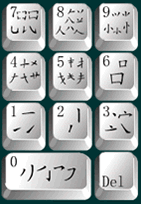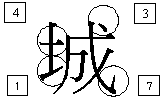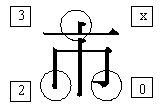CKC Chinese Input Systemis Available at CityU
When we talk about Chinese input method in the subject of "Chinese Computing", you will immediately relate this to the "Chang Jie




CKC Chinese Input System



The software plugs well into the XP environment and supports the Hong Kong Supplementary Character Set (HKSCS - 4702 Hong Kong characters) [Ref: 3]. After successful installation, an option of



When users have selected the


This input method is a keyboard input one. Actually, it only uses a maximum of 4 digits ("0" - "9") to represent a character. Strokes




In case users forget one or two digit mapping, they can always click on the"


The main principle of composing "CKC" code

-
Take the stroke of the upper left hand corner of the character as the first code
-
Take the stroke of the upper right hand corner of the character as the second code
-
Take the stroke of the lower left hand corner of the character as the third code
-
Take the stroke of the lower right hand corner of the character as the fourth code
e.g

In the above example, the first code of the character "


e.g

In this example, the "CKC" code of "

Users have to use the numeric pad to key in the code and complete the input with a space. If more than one character can be represented by the same "CKC" code, the system will show all the characters for selection. Users can use numeric pad "0"-"9" for selection, or use "PageUp" / "PageDown" to turn to the other pages.
One of the strengths of CKC Chinese Input System is that it caters for the input of phrases to increase input speed. The system has predefined more than 250,000 common Chinese phrases, such as "

The principles of composing "CKC" code for Chinese phrases are:
-
For 2-character phrase
-
To get the first 3 digits at most of each character. It forms the 3+3 coding principle. The minimum number of digit of this phrase is 2 and the maximum 6.
-
E.g. the "CKC"code of "" is 4804, and "" is 300. However, the code of the phrase "" is 480300.
-
-
For 3-character phrase
- To get first 2 digits at most of each character. It forms the 2+2+2 coding principle. The minimum number of digit of this phrase is 3 and the maximum 6.
- E.g. the "CKC"code of "
" is 5100, "" is 7770 and "" is 4297. The code of the phrase "" becomes 517742.
-
For 4-character phrase
- To get the first 2 digits at most of the first character, then the first digit of the second and third character. Finally, the first 2 digits at most of the fourth character. It forms the 2+1+1+2 coding principle. The minimum number of digit of this phrase is 4 and the maximum 6.
- E.g. the "CKC"code of "
" is 868, "" is 3367, "" is 800 and "" is 100. The code for the phrase "" becomes 863810.
-
For Multi-character phrase
- To get the first 2 digits at most of the first character, then the first digit of the second, third, fourth and fifth character, and the rest of characters are ignored. It forms 2+1+1+1+1 coding principle. The minimum number of digit of this phrase is 5 and the maximum 6.
- E.g. the "CKC"code of "
" is 06, "" is 3417, "" is 0450, "" is 6200, "" is 0120, "" is 1814 and "" is 7171. The code of the phrase "" is then 063060.
From the above illustration, you can see that if users input "




The purpose of this article is to introduce CKC Chinese Input System. Other features of this input method are left for users to explore.
References:
-
For more detail of the input method, please visit the home page ofat http://www.ckcsys.com.hk

-
Hong Kong Supplementary Character Set Document (HKSCS or) at http://www.info.gov.hk/digital21/eng/hkscs/document.html























